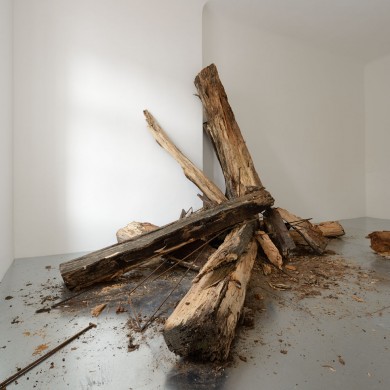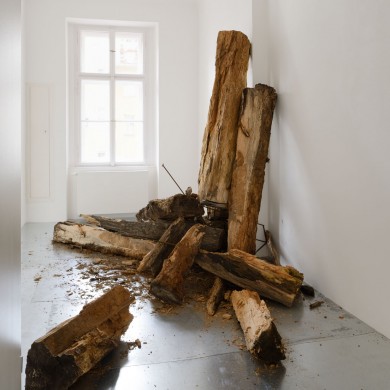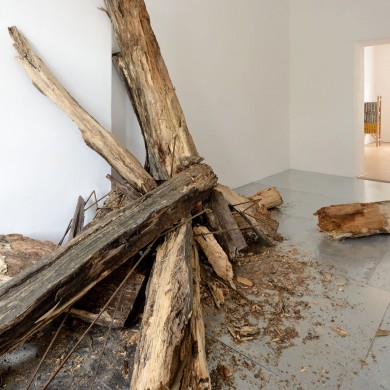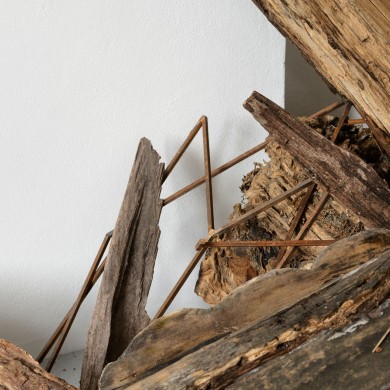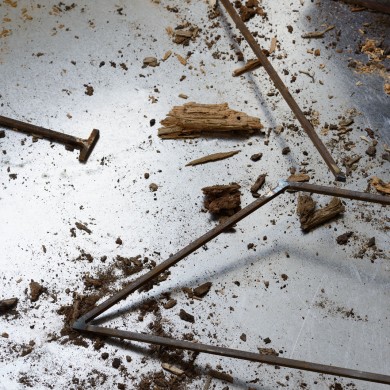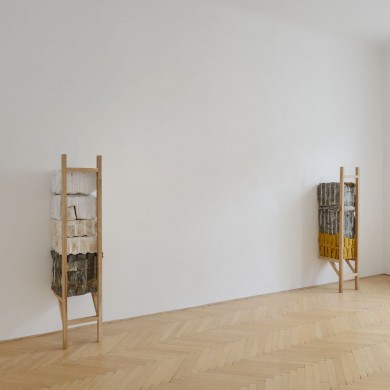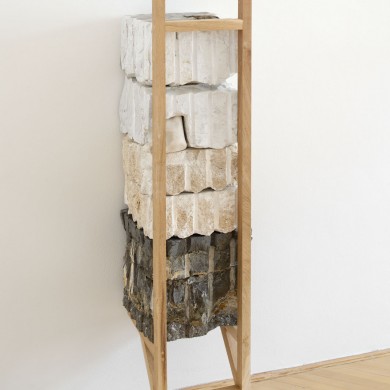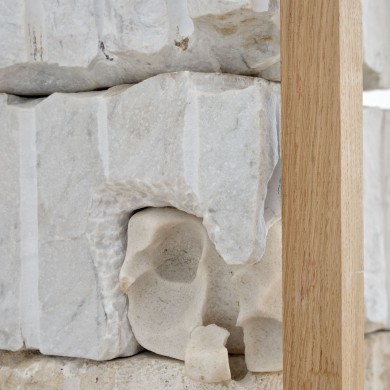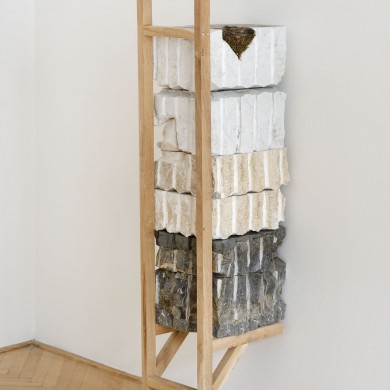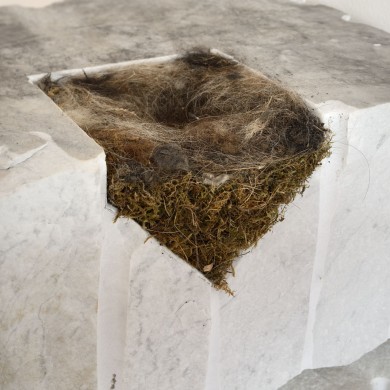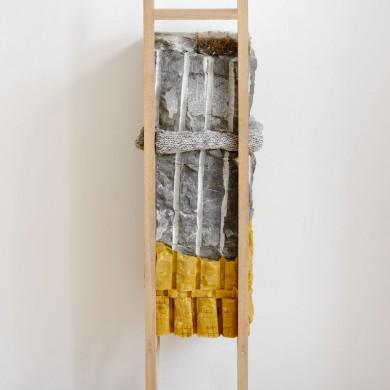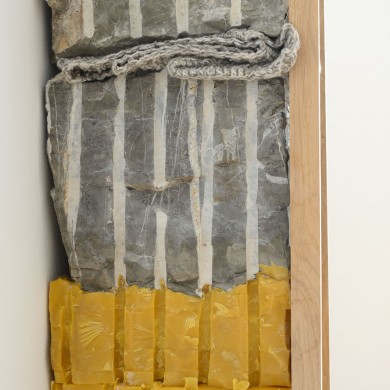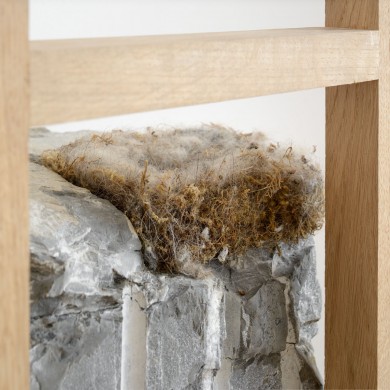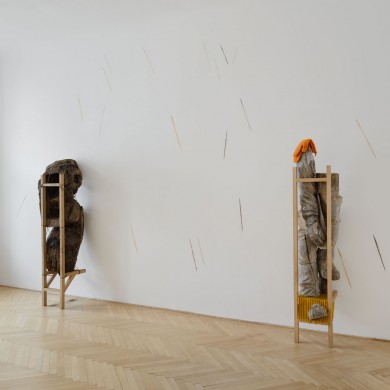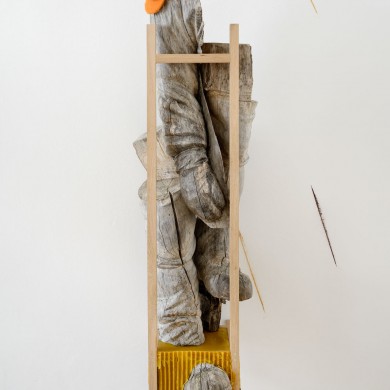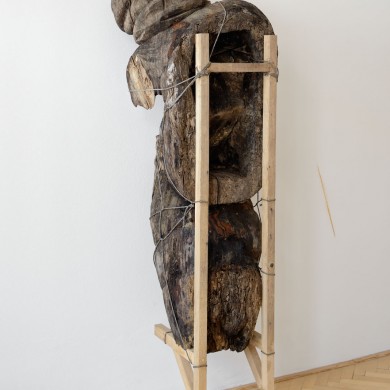Štefan Papčo
Where I Have Been Not
curated by Simona Dvořáková
14 Dec 2021 – 20 Jan 2022
ZAHORIAN & VAN ESPEN Prague
“The Mushroom at the End of the World: On the Possibility of Life in Capitalist Ruins” (2015) is a book by the American anthropologist Anna Tsing. She is describing the merry-go-round of a world that believes in the eternal rehabilitation of Nature, which will always rise again amid the ruins of various societies. Taking as her example the Japanese mushroom matsutake, one of the most expensive foodstuffs on earth, which is found on Oregon pines, the author maps this mysterious occurrence in ruined forests. These forests require a peculiar mode of observation, neglected by those who demand that reality should subordinate itself to their personal categories and should answer their personal questions. What Tsing calls an “art of observation” is required here, because mutsake casts doubt on classifications as we know them. Mutsake finds in ruins an opportunity to live anew. In ruins, where government is seen to by Nature.
The work of the Slovak artist Štefan Papčo might be seen as an “art of observation” such as Anna Tsing has defined. “Where I Have Been Not” is a current exhibition where Papčo poses a conceptual question about the nature of places, imaginary homes, and the act of transition. He is thinking of place not in the geographical sense, but rather as a mental place which connects with those physical places. Thus he conceives it as a perception of their temporality: the future, the memory, and the present. This subtle dialogue between material and spiritual spaces is closely bound up with the observation of natural progressions, human and animal footprints, and vigilant awareness of the world around us.
At the entrance to the ZAHORIAN & VAN ESPEN Gallery in Prague, Papčo placed the installation Broken Pillar – Broken Me (2021), made up of pieces of wood and metal trade symbols. This fragment of forest and mountain simultaneously bears witness to a merry-go-round of appearance and disappearance; the wood gradually degenerated more than would allow the artist to use it. In this instance the form of dissolution, the vital transformation of the original thought, is a moment present between thought and knowledge. A similar moment is the motif of the metal trade symbols, peeping out in slack pyramidal lines from under the wood. These symbols are visual guides for an ascent on the pillar which Papčo wished to reach. However, the pillar fell before he could do that.
In an ancillary room, placed on opposite walls, is the group of four sculptures of the installation Where I Have Been Not. On the left-hand side, He Thought of Connectness, 2021 and He Thought of Lightness, 2021, sculptures that carry a bird’s nest on top of them. Papčo originally placed this nest on trees after a period of six months. Birds made temporary homes for themselves in the conical stone depression, coming from a variety of places. Only they themselves know their origin from all the little feathers they left behind them, the mosses and twigs which they brought with them. Their journey is now captured in a majestic artefact: on abraded stone blocks or beeswax, resins from trees, and other natural materials from Central Slovakia. The blocks are set in a wooden construction serving for attachment to rucksacks and carrying materials and foodstuffs to the mountain summits. The construction, evoking upwards movement, is both contemplative and corporal.
Papčo continued developing the tension between the inner and outer place via further intensive and processual work. The counterposed sculptures He Thought of Eden, 2021 and He Thought of Silence, 2021 constitute a record of something intimate, unknown and alienated. Fragments of a human body exposed to time, sun, gravitation, rain and snow, are carved from wood and fixed to support a wooden construction that seems to have the responsibility of preserving the fragile remains, living reliquaries and metamorphoses of the forest.
“Where I Have Been Not” carries within it the essence of Julius Koller’s Ganek Gallery. Koller, via diverse artistic interventions that sang of sci-fi fantasy and such mysterious places as Atlantis, the Bermuda Triangle, or the UFO, with boundless imagination sought a means of creating “a new space” for “new cultural actions” within totalitarian Czechoslovakia. The Ganek Gallery is a place that is ideal, ambivalent, real, and at the same time imaginary, on a peak in the Tatra mountain range. An area for resting on a mountaineering ascent, where no exhibition ever has been held. It is a refuge for a hopeful idea of humanity, between the physical and the imaginary worlds.
“Where I Have Been Not” is that area, an exhibition of observations of the thought and government of Nature. With sensitivity and care, with a melody of minimal forms, Štefan Papčo here makes a record of spiritual sequences and vital transformations.
Americká antropoložka Anna Tsing, popisuje v knize „The Mushroom at the End of the World: On the Possibility of Life in Capitalist Ruins“ (2015) koloběh světa který věří ve věčnou rehabilitaci přírody, která se vždy opět vzedme mezi ruinami rozličných společenství. Autorka na příkladu japonských hub matsutake – jedny z nejdražších potravin na světě – nalezených na oregonských borovicích, mapuje tento záhadný výskyt ve zničených lesích. Tyto lesy, vyžadují způsob pozorování, který zanedbávají ti, kdo požadují, aby se realita podřizovala jejich vlastním kategoriím a odpovídala na jejich vlastní otázky. Vyžadují to, co Tsing nazývá ‚umění pozorování‘, neboť mutsake zpochybňují klasifikaci našich znalostí. Mutsake nacházejí v ruinách možnost znovu žít. V ruinách, kde se vlády ujímá příroda.
‚Uměním pozorování‘ tak jak ho definuje Anna Tsing, by se dala vnímat práce slovenského umělce Štefana Papča. „Where I Have Been Not“ aneb „Kde jsem nebyl“ je aktuální výstava ve které si Papčo klade konceptuální otázku po povaze míst, imaginárních domovů a aktu přechodu. Tato místa nejsou myšlena jako místa geografická, nýbrž jako místa mentální, která se s těmi fyzickými pojí. Tak jako vnímání jejich časovosti – budoucnosti, vzpomínky a přítomnosti. Tento jemný dialog mezi hmotným a duševním prostorem je úzce propojen s pozorováním přírodních pochodů, lidské i zvířecí stopy a bedlivého vnímání světa kolem nás.
Papčo umístil do vchodu galerie ZAHORIAN & VAN ESPEN Praha instalaci Broken Pillar – Broken Me (2021) složenou z kusů dřeva a kovových značek. Tento fragment lesa a hory je zároveň svědectvím o koloběhu vzniku a zániku; dřevo postupně degenerovalo, než ho umělec mohl použít. Forma rozkladu, vitální proměna prvotní myšlenky, je zde přítomným momentem mezi představou a poznáním. Podobným momentem je motiv kovových značek vykukujících ve slabých pyramidálních liniích zpod dřeva. Tyto značky jsou vizuální vodítka k výstupu na pilíř, na který se chtěl Papčo dostat. Pilíř však spadnul předtím, než tak mohl učinit.
Ve vedlejší místnosti je na protilehlých stěnách umístěna čtveřice soch instalace Where I Have Been Not. Po levé straně. He Thought of Connectness, 2021 a He Thought of Lightness, 2021, sochy nesoucí na svém vršku ptačí hnízda. Papčo tato hnízda původně umístil po dobu šesti měsíců na stromech. V kamenné kuželovité prohlubni si ptáci vytvořili dočasné domovy pocházející z rozličných míst. Jen oni sami znají jejich původ ze všech peříček, která po sobě zanechali, mechu, větviček, které si přinesli. Jejich cesta je nyní zachycena v majestátním artefaktu; na obrušovaných kamenných blocích nebo i včelího vosku, smůly ze stromů a dalších přírodnin ze středního Slovenska. Bloky jsou zasazeny do dřevěné konstrukce sloužící k uchycení krosen a vynášení materiálu a potravy na vrcholky hor. Konstrukce, evokující pohyb vzhůru, jak kontemplativní, tak tělesný.
Papčo pokračoval v rozvíjení napětí mezi vnitřním a vnějším místem prostřednictvím další intenzivní a procesuální práce. Protilehlé sochy He Thought of Eden, 2021 a He Thought of Silence, 2021 jsou záznamem intimním, nepoznaným a odcizeným. Fragmenty lidského těla vystaveny času, slunci, gravitaci, dešti a sněhu, jsou vyřezaný ve dřevě a upevněny k podpoře dřevěné konstrukce jakoby se starostí o zachování křehké formy ostatků, živé relikvie a metamorfózy lesa.
„Where I Have Been Not“ má v sobě esenci legendární Galerii Ganků Júliuse Kollera. Koller, skrze rozmanité umělecké intervence opěvující sci-fi fantazii a tajemná místa jako Atlantis, Bermudský trojúhelník, nebo Ufo, pátral pomocí bezmezné fantazie po způsobu vytvoření ‚nového prostoru‘ pro ‚nové kulturní akce‘ uvnitř totalitního Československa. Galerie Ganků je místo ideální, ambivalentní, reálné a zároveň smyšlené na vrcholku hřebenů Tater. Plošina odpočinku alpinistického výstupu, na které se nikdy žádná výstava nekonala. Je útočištěm nadějné ideje lidství, mezi fyzickým a smyšleným světem.
„Where I Have Been Not“ je onou plošinou, výstavou pozorování myšlenky a vlády přírody. Štefan Papčo zde s citlivou péčí zaznamenává melodicky minimálními tvary, spirituální sekvence a živé proměny.
Annual visual art programme of ZAHORIAN & VAN ESPEN Prague is implemented with financial support of city district of Prague 7

